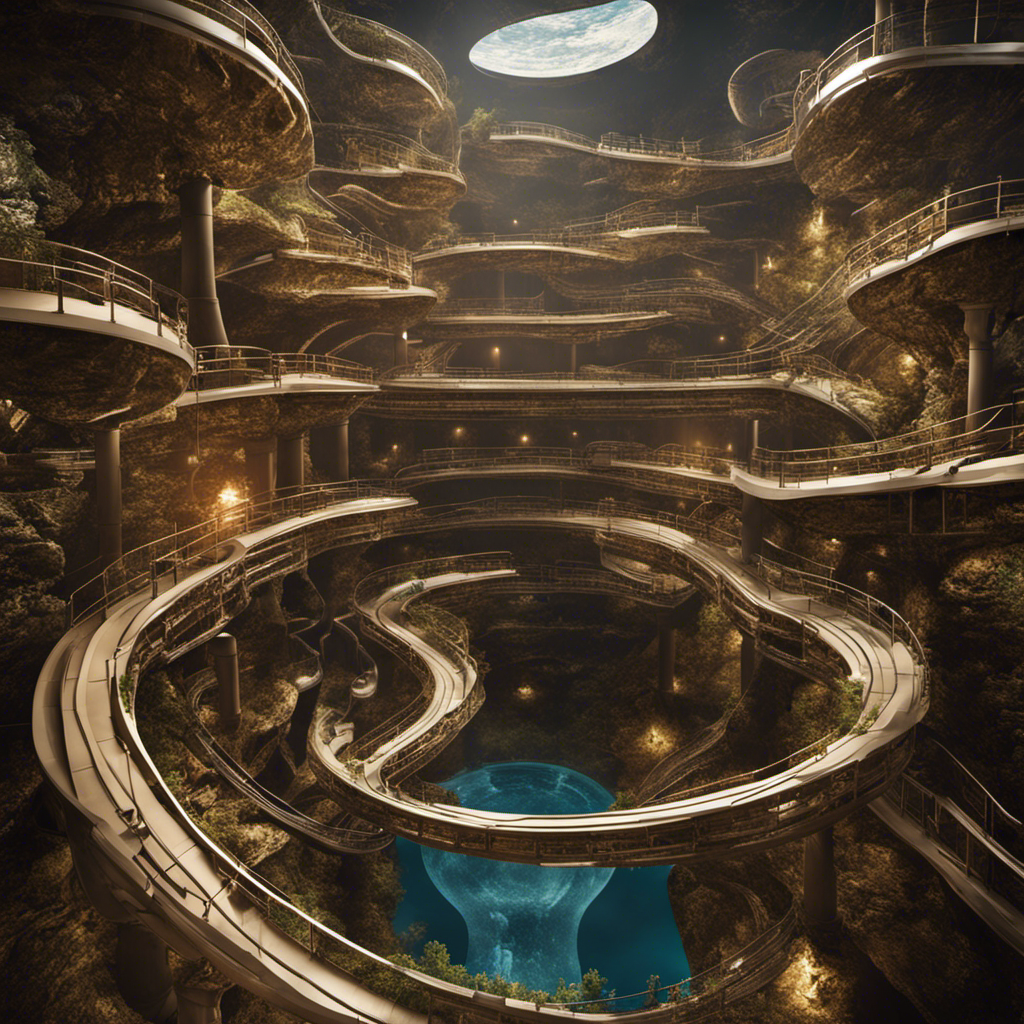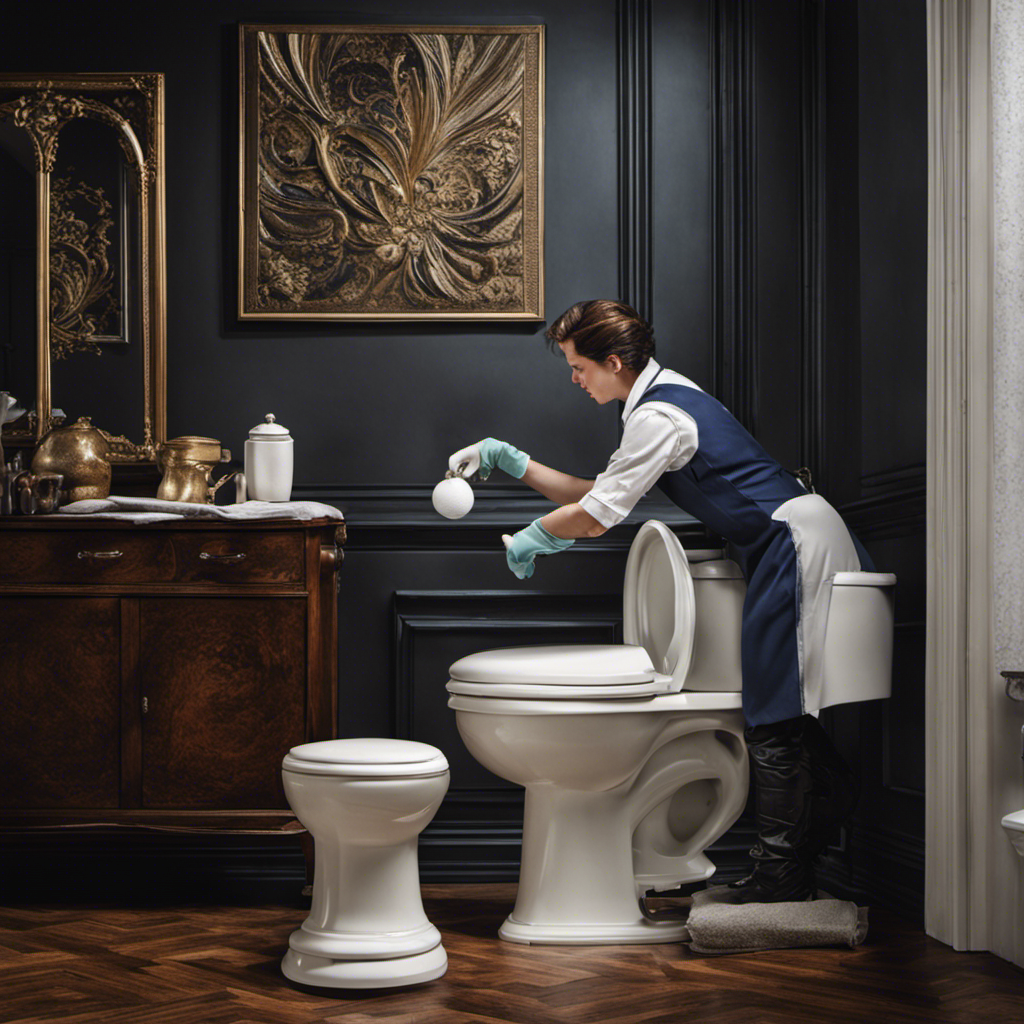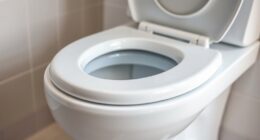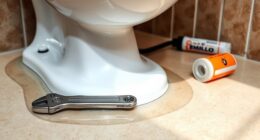Have you ever wondered where toilet water goes after you flush? Well, prepare to be amazed as I take you on a journey through the intricate process of waste disposal.
From the moment you press that lever, the water begins its swift descent through a labyrinth of pipes. But what happens next? How is this waste treated? And what impact does it have on our environment?
Join me as we explore the fascinating world of toilet water and discover the innovations in waste management that are shaping our future.
Key Takeaways
- Toilet water flows into the bowl when the flush lever is pressed, creating a powerful force that propels waste through the trapway.
- Gravity guides the waste towards the sewage treatment plant, where it undergoes a series of processes including filtration, purification, sedimentation, and disinfection.
- Improper waste disposal can have a detrimental environmental impact, including polluting water bodies, harming marine life, and contributing to climate change.
- Innovations in waste management, such as the use of drones, are improving recycling solutions, waste collection, and overall efficiency in waste management processes.
The Process of Flushing
When you flush the toilet, the water and waste get sucked into the pipes and go to the sewage treatment plant. The mechanics behind the toilet flush involve a simple yet efficient system.
As you press the flush lever, a valve opens, allowing water from the tank to rush into the bowl. This sudden influx of water creates a powerful force that propels the waste through the trapway and into the sewage pipes. The trapway, a curved channel at the base of the toilet, helps to prevent any backflow or odors from escaping.
Once the waste enters the pipes, gravity takes over, guiding it towards the sewage treatment plant. From there, the waste undergoes a series of processes to be treated and safely disposed of.
Understanding the mechanics behind the toilet flush helps us appreciate the engineering and technology involved in managing our waste effectively.
The Journey Through the Pipes
As it travels through the pipes, toilet water undergoes a complex journey. It is important to understand this process in order to appreciate the importance of proper pipe maintenance and water conservation. Here is a breakdown of the journey:
-
Flushing: When you press the flush button, the water is released from the tank and rushes into the bowl, carrying away the waste.
-
Drainage: The flushed water, along with the waste, flows down the drainpipe and enters the sewer system.
-
Treatment: The sewage is transported to a wastewater treatment plant, where it undergoes a series of processes to remove contaminants and pollutants.
-
Discharge: After treatment, the water is discharged into a nearby body of water, where it can be reused or returned to the natural environment.
Understanding the journey of toilet water highlights the importance of maintaining pipes to ensure proper flow and conserving water by using efficient flushing methods.
Treatment at the Sewage Plant
The flushed water, along with the waste, goes through a series of processes at the wastewater treatment plant to remove contaminants and pollutants.
At the plant, one of the key processes is sewage filtration. This involves passing the water through screens to remove large solids like toilet paper and other debris.
After filtration, the water undergoes water purification. This step involves the use of chemicals like chlorine or ozone to kill any remaining bacteria and viruses.
The water is then further treated through a process called sedimentation, where solids settle to the bottom, and the clear water is separated.
Finally, the water goes through disinfection to ensure any remaining pathogens are eliminated.
This thorough treatment process ensures that the water is safe to be returned to the environment or reused for various purposes.
Environmental Impact of Waste Disposal
One of the main sources of pollution is the improper disposal of waste. This issue has a significant impact on marine ecosystems, leading to devastating consequences for aquatic life.
To evoke an emotional response from the audience, consider the following list:
- Plastic waste, including bottles and bags, is often dumped into oceans, endangering marine animals who mistake it for food.
- Chemical waste from industries and households seeps into water bodies, contaminating the water and harming aquatic organisms.
- Improperly treated sewage waste contains high levels of nutrients that can lead to harmful algal blooms, suffocating marine life.
- Landfill waste releases greenhouse gases, contributing to climate change and acidification of the oceans.
To address these issues, waste reduction strategies are crucial. Transitioning to sustainable packaging, promoting recycling, and implementing stricter regulations on waste disposal are some effective measures. These strategies aim to minimize the negative impact on marine ecosystems and ensure a cleaner and healthier environment.
In the subsequent section, we will explore innovations in waste management that further contribute to environmental sustainability.
Innovations in Waste Management
There’s been a recent development in waste management that involves using drones to identify and collect litter in hard-to-reach areas. This innovation holds great promise for improving recycling solutions and addressing the challenges of waste management.
Drones equipped with cameras and sensors can efficiently locate and assess litter in remote or inaccessible locations, such as forests, mountains, or bodies of water. By identifying and collecting this litter, drones can significantly contribute to reducing environmental pollution and improving recycling rates.
This technology has the potential to revolutionize waste management practices by increasing efficiency, reducing costs, and minimizing human intervention. Moreover, the future prospects for this innovation are highly promising, with advancements in drone technology and artificial intelligence expected to further enhance their capabilities in waste management.
Frequently Asked Questions
Is It Safe to Drink Water From the Toilet After It Has Been Flushed?
No, it is not safe to drink water from the toilet after it has been flushed. There are potential health risks associated with consuming toilet water due to the presence of harmful bacteria and contaminants.
How Long Does It Take for Toilet Water to Reach the Sewage Plant?
Toilet water flows through the sewage system at lightning speed, thanks to the remarkable efficiency of modern plumbing. The time it takes for toilet water to reach the sewage plant is a testament to the marvels of engineering and wastewater management.
What Happens to the Solid Waste That Is Removed at the Sewage Plant?
After the solid waste is removed at the sewage plant, it undergoes a process called solid waste disposal. This process involves separating the waste into different components and treating them accordingly to ensure proper disposal and environmental safety.
Can Flushing Certain Items Down the Toilet Cause Damage to the Pipes?
Flushing hazards can indeed cause damage to toilet pipes. Certain items like wipes, paper towels, and feminine hygiene products can clog the pipes and lead to costly repairs. It is important to only flush toilet paper and waste.
Are There Any Alternative Methods for Waste Disposal Being Developed?
Resource management and innovative technologies are being explored for waste disposal. Alternative methods are being developed to efficiently handle waste and minimize environmental impact. These advancements aim to improve sustainability and optimize waste treatment processes.
Conclusion
In conclusion, the journey of toilet water is an intricate and fascinating process. From the moment we flush, the water embarks on a complex adventure through a labyrinth of pipes, eventually ending up at the sewage treatment plant.
This journey is a reminder of how our waste can have a significant environmental impact if not managed properly. However, with innovations in waste management, we have the opportunity to turn this waste into a valuable resource.
Let us strive to embrace these innovations and transform our waste into something beautiful, just like a butterfly emerging from its cocoon.










